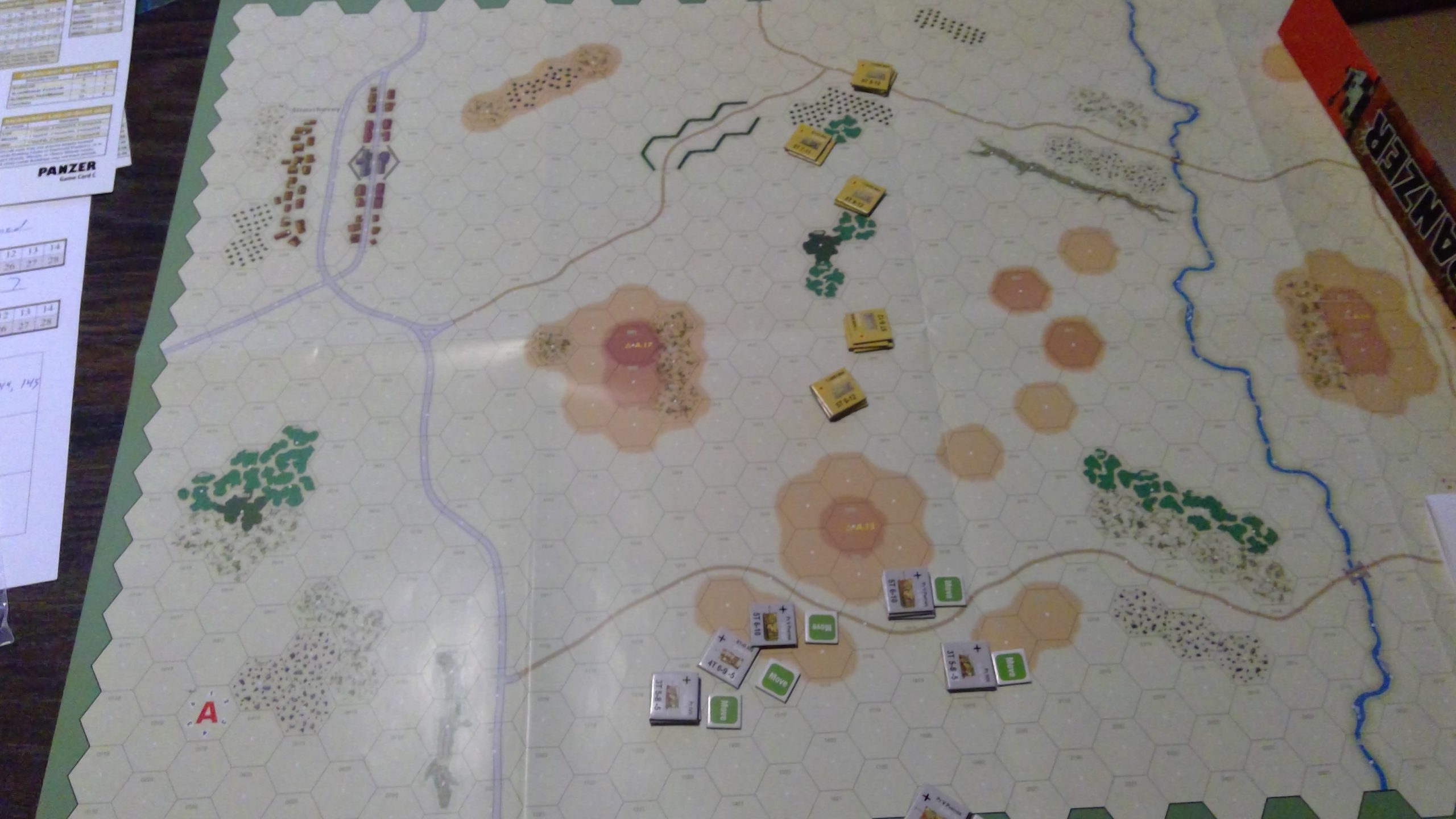The Panzer Villiage
Jason came over on Jan 16th to introduce me to GMT’s Panzer. I was slightly aware of the original Yaquinto games back in the day, and looked over the AH MBT box at the end of the ’80s, but had no actual experience with the system, which Jason and Mark have been enjoying. Certainly, the production values with those thick mounted reference cards are really impressive.
I read through the basic rules, but we ended up with something of an amalgam of that and some advanced rules (the full hit locations, the damage roll, organization and orders by platoon) and some of Jason’s preferred adjustments (separate initiative per order, and the turret facing optional rule), and played scenario #2 (“The Village”) from the main set twice.
I had the Germans the first time, and entered at the bottom of the board. After setup, I realized that one Russian platoon was visible on a level 2 hill, and ordered a Panther platoon to fire on it before it moved, but narrowly missed at medium range. The command Panther set up for overwatch on a ridgeline, half the PzIV platoon set up to do the same if he came between the main hill sets, and everything else was still maneuvering, while Jason sent the bulk of his force towards the victory village while two platoons headed for the hills.
Jason was generally happy to move first, and I was happy to let him, so we skipped movement initiative rolls for the first couple turns. This allowed me to out-maneuver him, and start knocking out tanks during turn two. I took some hits of course; the StuG moved onto the ridgeline on 2, and was immobilized there on 3. The battle around hill A.11 got a bit tricky, but I had the advantage, which I used to finish off the combat, and then flush him out of the village. We didn’t play that out, but a calculation of victory points showed I was over 400 VP ahead after knocking out most of the Russian tanks, so even if he technically ‘held’ the village, I would have the 100 VP for the win.
We reversed sides and setup positions for round two, so it was effectively a replay, but we were seeing things differently. I set up not to be on that one hill hex, though it was tempting. Combat centered on an area a bit more ‘north’ and ‘east’ than the first game, and I continued doing all I could to outmaneuver Jason, which was needed. I didn’t do nearly as well this time, mostly because Jason largely kept me on the front of his Panthers. T-34/85s just can’t penetrate that, and my front/side shots mostly ended up hitting the front. The SU-100 was a big help, and cornered a pair of Panthers against the three-hex woods area in the center… and kept getting track hits! Even immobile, they gave better than they got. A separate combat raged around the village, and we called it as my final two platoons moved to finish off the Germans in the center (…which would have probably been a dumb thing to actually do, as I should have plenty of VPs, and could easily lose more than I gained).
I got to see some of the rest of the kit for the expansions, and the number of geomorphic boards available is pretty impressive. It was interesting to note that they’re 10 hexes by 32 hexes like the AH boards (I wonder if PanzerBlitz is the original prototype for these), but a bit bigger than I’m used to because of the larger hexes. The initial cut versions are interesting, but I agree that the later tri-fold versions are better. If GMT is smart, they’ll take a look at the ‘vertical’ boards for ASL, though their different road hookups used might turn into a problem (won’t be nicely centered on the half-board).
Overall, it seems a well-done game, and the general rules engine seems good. I do have some problems with the components: The counters are nice and big, and fill the nice big hexes from edge to edge. This means if two vehicles are in adjacent hexes, and facing different directions, there’s not enough room. The orientation of the text on the counter to ‘front’ is different between infantry & planes and vehicles & guns (frankly, all going with the top of the counter as front would have been better). And while I appreciate keeping the counters uncluttered (since you can’t put all the info on them anyway), a few basic pieces of info, like turret/no-turret or size modifier might still be handy (the latter especially, as its the only target firing info you need).
In fact, I find it interesting that Panzer uses the same size ratings as ASL (so far as I’ve seen, they match anyway), and the same +2 for firing at a moving target. Past that, it is largely more detailed, with a few things ASL seems a bit more detailed on (e.g., amount of time in view targeting penalties) easily viewable as part of the smaller scale of ASL. Moving from simple modifiers to a percentile roll works well in practice, but I kind of wonder if just using something like GURPS‘ 3d6 resolution would have worked about as well without needing the table in between.
At any rate, the armor and penetration details seem to be nice balance between lots of detail, and simple enough to manage, giving the entire game a true ‘minis game on hex grid’ feel. I’m sure this won’t be the last time I try the system.


Discussion ¬